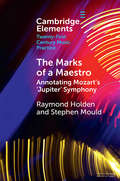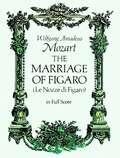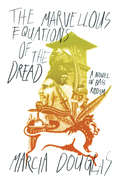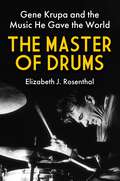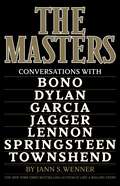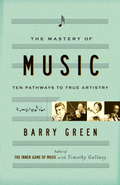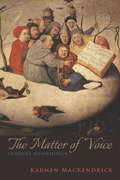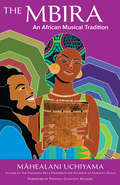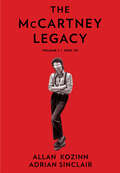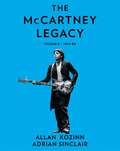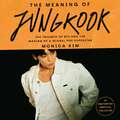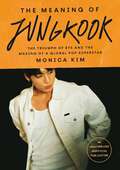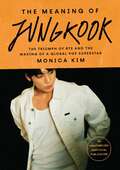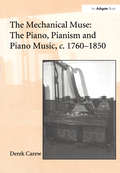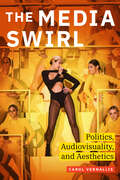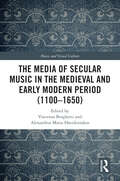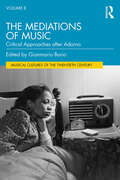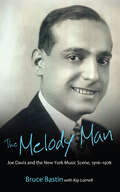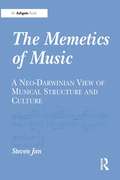- Table View
- List View
The Marks of a Maestro: Annotating Mozart's ‘Jupiter' Symphony (Elements in Twenty-First Century Music Practice)
by Stephen Mould Raymond HoldenOnly recently has it become obvious that conductors' annotated scores and marked orchestral parts are of great cultural, historical and musical importance. In the not-so-distant past, these artefacts had something of an uncertain status with many either languishing unopened in libraries and family archives or simply being dispersed or discarded. With the help of institutions such as the Royal Academy of Music, Harvard University and the New York Philharmonic Orchestra this has begun to change with their extensive collections of these materials now being made available to scholars and musicians. This element examines the emergence of these artefacts as didactic and interpretative tools and explores the ways in which the performance styles of ten iconic conductors active in the nineteenth, twentieth and twenty-first centuries are reflected in their annotated scores and marked orchestral parts of Mozart's Symphony No. 41, K. 551 ('Jupiter').
The Marriage of Figaro: A Comic Opera In Three Acts, Founded On Beaumarchais' Comedy Of La Folle Journée, And On The Follies Of A Day (Dover Opera Scores)
by Wolfgang Amadeus MozartNow available for the first time in a sturdily produced, reasonably priced paperbound edition is the complete orchestral score of Mozart's The Marriage of Figaro, widely considered the greatest comic opera ever written. Based on the second play of a trilogy by Beaumarchais (the first was The Barber of Seville), Figaro elevates the time-honored opera buffa of Italian tradition to new heights, transfiguring persons and scenes with glorious melodies and superb dramatic characterizations.This edition, based on Mozart's autograph manuscript and early German translations of the libretto, embodies both the original Italian libretto of Lorenzo Da Ponte and a new corrected version of the German text. It is totally complete and contains all passages, including some that are missing from other editions and often cut in performances. In addition, the Editor's Commentary includes a complete review of all dubious passages and text problems.This full orchestral score is an indispensable aid for study and for anyone listening to recordings or live performances. In no other manner can the listener or student keep full awareness of the many elements that make up this opera.
The Marvellous Equations of the Dread: A Novel In Bass Riddim
by Marcia DouglasThe ancestors have awakened. Somebody has called them. The long-dead are stirring. Jah ways are mysterious ways. “Is me—Bob. Bob Marley.” Reincarnated as homeless Fall-down man, Bob Marley sleeps in a clock tower built on the site of a lynching in Half Way Tree, Kingston. The ghosts of Marcus Garvey and King Edward VII are there too, drinking whiskey and playing solitaire. No one sees that Fall-down is Bob Marley, no one but his long-ago love, the deaf woman, Leenah, and, in the way of this otherworldly book, when Bob steps into the street each day, five years have passed. Jah ways are mysterious ways, from Kingston’s ghettoes to London, from Haile Selaisse’s Ethiopian palace and back to Jamaica, Marcia Douglas’s mythical reworking of three hundred years of violence is a ticket to the deep world of Rasta history. This amazing novel—in bass riddim—carries the reader on a voyage all the way to the gates of Zion.
The Master of Drums: Gene Krupa and the Music He Gave the World
by Elizabeth J. RosenthalThe first definitive biography of Gene Krupa, the most famous drummer on the planet, whose feverish rhythms defined the Swing Era, changed jazz music forever, spurred rock and roll, and influenced generations. From the early 1930s onward, Gene Krupa was a drum-centric rarity in the jazz world. Never before had a drummer been in the forefront as a solo artist. His galvanizing, unrestrained passion for percussion demanded it. Rocking the rafters, Gene thrilled audiences in ballrooms, nightclubs, and movies. He always knew he would. It was in his blood. Seemingly born jazz-drum crazy in 1909 to a Polish-immigrant working-class family in South Chicago, Gene was a professional by the age of thirteen and soon made his first recordings. By the early 1930s, he was New York City&’s most in-demand drummer, and starting in 1934, he joined brilliant clarinetist Benny Goodman&’s band, helped inaugurate the Swing Era, and played the first-ever swing concert at Carnegie Hall, which made history. So did Gene, whose celebrity spread with every ride cymbal beat and bass drum bomb drop. He formed his own band, hired such dazzlingly outsized personalities as singer Anita O&’Day, and unconditionally shattered racial boundaries by sharing the spotlight with the blistering African-American trumpeter Roy Eldridge. But after a skyrocketing ride to the top, Gene experienced a roller-coaster ride of good and bad luck, emotional highs, and devastating depths. In The Master of Drums, biographer Elizabeth J. Rosenthal crafts a celebratory, honest, and exhaustively researched portrait of a twentieth-century music legend whose acolytes would include such rock-era artists as Ringo Starr, Keith Moon, John Bonham, and Apollo 440. When he died, Gene Krupa may have left behind a world of grieving friends, colleagues, fans, students, and progeny, but as The Master of Drums proves, his dynamic musical and cultural influences live on. Foreword by Slim Jim Phantom of the Stray CatsIncludes 16 pages of exclusive, never-before-seen photographs
The Masters: Conversations with Dylan, Lennon, Jagger, Townshend, Garcia, Bono, and Springsteen
by Jann S. WennerFrom New York Times bestselling author and Rolling Stone founder comes "a visit to the Mount Olympus of rock" in this remarkable collection of new and collected interviews with some of the greatest rock stars and cultural icons of our time (Kirkus Reviews). During fifty years of publishing the &“Bible of Rock and Roll,&” Jann Wenner conducted a series of interviews that are now regarded among the most important historical documents of rock. Some of these conversations broke headlines—in 1970, his interview with John Lennon exposed the unvarnished tensions that led to the breakup of the Beatles. He gets up-close-and-personal with Bob Dylan, the most singular figure in music who revealed himself to Wenner more openly than to anyone else. And Mick Jagger only trusted one person to publicly interview him about his private life and his backstage account of the world's greatest rock band. Including stunning photographs and an exclusive, never-before-seen interview with Bruce Springsteen, The Masters intimately profiles the extraordinary musicians who dominated rock and roll, from London and California to New York and L.A.. This is a primary source, cultural masterpiece, and must-have volume about the artists who changed history.
The Masterwork in Music: Volume I, 1925
by Richard Kramer Heinrich Schenker William Drabkin Ian Bent John Rothgeb Hedi SiegelThe three volumes of The Masterwork in Music present complete English translations of major works by Austrian music theorist Heinrich Schenker, one of the twentieth century's leading figures in the field. First published in German between 1925 and 1930, these essays represent Schenker's greatest writings in analysis prior to the 1935 definitive formulation of his theory of music in Der freie Satz (Free Composition). This new publication of the long-awaited English translation, which first appeared in the distinguished Cambridge University Press edition, provides a valuable resource for scholars. Editorial annotations and elucidations by Dr.William Drabkin and his translators offer additional insights. Volume One includes analyses of keyboard pieces by Bach, Scarlatti, Chopin, and Beethoven, along with studies of solo violin music by Bach. Volume Two contains a major essay on Mozart's Symphony No. 40 in G minor and shorter studies of works by Bach, Haydn, and Reger. Volume Three's contents include Schenker's celebrated analysis of Beethoven's "Eroica" Symphony and other works.
The Masterwork in Music: Volume II, 1926
by Heinrich Schenker William Drabkin Ian Bent John Rothgeb Hedi SiegelThe three volumes of The Masterwork in Music present complete English translations of major works by Austrian music theorist Heinrich Schenker, one of the twentieth century's leading figures in the field. First published in German between 1925 and 1930, these essays represent Schenker's greatest writings in analysis prior to the 1935 definitive formulation of his theory of music in Der freie Satz (Free Composition). This new publication of the long-awaited English translation, which first appeared in the distinguished Cambridge University Press edition, provides a valuable resource for scholars. Editorial annotations and elucidations by Dr. William Drabkin and his translators offer additional insights. This volume features a major essay on Mozart's Symphony No. 40 in G minor; studies of Bach keyboard and solo cello pieces; works by Haydn and Reger; theoretical writings on sonata form and fugue; and many examples of Schenkerian theory. Volume One includes analyses of keyboard works by Bach, Scarlatti, Chopin, Beethoven, and Handel and solo violin music by Bach, along with studies of other works. Volume Three's contents include Schenker's celebrated analysis of Beethoven's "Eroica" Symphony and other works.
The Masterwork in Music: Volume III, 1930
by Heinrich Schenker William Drabkin Ian Bent Alfred Clayton Derrick PuffettThe three volumes of The Masterwork in Music present complete English translations of major works by Austrian music theorist Heinrich Schenker, one of the twentieth century's leading figures in the field. First published in German between 1925 and 1930, these essays represent Schenker's greatest writings in analysis prior to the 1935 definitive formulation of his theory of music in Der freie Satz (Free Composition). This new publication of the long-awaited English translation, which first appeared in the distinguished Cambridge University Press edition, provides a valuable resource for scholars. Editorial annotations and elucidations by Dr. William Drabkin and his translators offer additional insights. This volume comprises the eminent Austrian theorist's main writings from the mid-1920s to 1930. In addition to essays on music theory in cultural context, the book is dominated by one of Schenker's most celebrated studies of a single work: the analysis of Beethoven's "Eroica" Symphony, which discusses all four movements in painstaking detail. Volume One includes analyses of keyboard works by Bach, Scarlatti, Chopin, Beethoven, and Handel and solo violin music by Bach, along with studies of other works. Volume Two contains a major essay on Mozart's Symphony No. 40 in G minor and shorter studies of works by Bach, Haydn, and Reger.
The Mastery of Music: Ten Pathways to True Artistry
by Barry GreenThe Inner Game of Music, the breakout hit that became a standard primer in the music world, has taught thousands of musicians--professionals and amateurs alike--how to overcome self-consciousness and stage fright and to recapture a youthful, almost effortless capacity to learn. Now, in his follow-up book, The Mastery of Music, Barry Green turns his expert hand to the artistic qualities that make an extraordinary musician. Culling advice from dozens of interviews with legends including Joshua Bell, Dave Brubeck, Jeffrey Kahane, Bobby McFerrin, Christopher Parkening, Doc Severinsen, Frederica von Stade, the Harlem Boys Choir, and the Turtle Island String Quartet, he reveals that it's not enough to have a cerebral and emotional connection to the notes. Green hows how musical excellence, exhibited by true virtuosos, requires a mastery of ten unique qualities of the soul and the human spirit, such as confidence, passion, discipline, creativity, and relaxed concentration, and he discusses specific ways in which all musicians, composers, and conductors can take their skills to higher levels. He carefully incorporates all instruments and techniques in his rejuvenating discussions, inspiring the stifled student to have fun again and the over-rehearsed performer to rediscover the joy of passionate expression. Essential reading for every musician, The Mastery of Music strikes a beautiful new chord.
The Matter of Voice: Sensual Soundings
by Karmen MacKendrickPhilosophers for millennia have tried to silence the physical musicality of voice in favor of the purity of ideas without matter, souls without bodies. Nevertheless, voices resonate among bodies, among texts, and across denotation and sound; they are singular, as unique as fingerprints, but irreducibly collective too. They are material, somatic, and musical. But voices are also meaningful—they give body to concepts that cannot exist in abstractions, essential to sense yet in excess of it. They can be neither reduced to neurology nor silenced in abstraction. They complicate the logos of the beginning and emphasize the enfleshing of all words. Through explorations of theology and philosophy, pedagogy, translation, and semiotics, all interwoven with song, The Matter of Voice works toward reintegrating our thinking about both speaking and authorial voice as fleshy combinings of meaning and music.
The Mbira: An African Musical Tradition
by Mahealani UchiyamaAn introductory guide to the mbira: the spiritual traditions, historical perspectives, and practical applications of a sacred Zimbabwean instrument.In this accessible overview steeped in history and tradition, teacher and student Māhealani Uchiyama offers insights for learning about the mbira and actively engaging with it in an informed and respectful way. The mbira is made of a wooden soundboard and hammered metal keys. It can be played solo or accompanied by singing, clapping, dancing, percussion, or other mbira. In traditional Zimbabwean culture, the mbira is a spiritual practice that bridges worlds: for example, the realm of the ancestors and of healing energies with the worlds of the living. Supplemented with 32 images and glossary of terms, this book helps readers understand: • The mbira&’s special roles within the lamellaphone instrument family • Relevant Zimbabwean and African cultural, historical, and spiritual perspectives • Ways the mbira can become a connection point for people severed from their African roots • How appropriation and commodification have contributed to the mbira&’s popularization around the world • Codes of conduct for respectfully playing the mbira and for taking it up as a practice
The McCartney Legacy: Volume 1: 1969 – 73
by Allan Kozinn Adrian SinclairIn this first of a groundbreaking multivolume set, THE MCCARTNEY LEGACY, VOL 1: 1969-73 captures the life of Paul McCartney in the years immediately following the dissolution of the Beatles, a period in which McCartney recreated himself as both a man and a musician. Informed by hundreds of interviews, extensive ground up research, and thousands of never-before-seen documents THE MCCARTNEY LEGACY, VOL 1 is an in depth, revealing exploration of McCartney’s creative and personal lives beyond the Beatles.When Paul McCartney issued a press release in April 1970 announcing that the world’s most beloved band, the Beatles, had broken up no one could have predicted that McCartney himself would go on to have one of the most successful solo careers in music history. Yet in the years after the Fab Four disbanded, Paul McCartney became a legend in his own right. Now journalist and world-renowned Beatles’ historian Allan Kozinn and award-winning documentarian Adrian Sinclair chronicle in technicolor McCartney’s pivotal years from 1969 to 1973, as he recreated himself in the immediate aftermath of the Beatles breakup – a period when, newly married and with a growing family, he conquered depression and self-doubt, formed a new band, Wings, and recorded five epochal albums culminating in the triumphant smash, Band on the Run.Part 1 of a multivolume set, THE MCCARTNEY LEGACY, VOL. 1 documents a pivotal moment in the life of a man whose legacy grows increasingly more relevant as his influence on music and pop culture remains as relevant as ever. It is the first truly comprehensive biography, and the most finely detailed exploration of McCartney’s creative life beyond the Beatles, ever undertaken.
The McCartney Legacy: Volume 2: 1974 – 80
by Allan Kozinn Adrian SinclairThe follow-up to The McCartney Legacy, Volume 1, the most complete work on the life and work of Paul McCartney ever published. Volume 2 continues to paint the portrait of one of the world’s greatest musicians, his work post-Beatles, and his life from 1974 to 1980.By 1974 the Beatles were a distant memory, and Paul McCartney had already gone on to release a solo album and form a new band, Wings. By the end of the decade Wings would be the bestselling band of the 1970s. The McCartney Legacy, Vol. 2 begins in 1974 at the height of Wings popularity and the beginning of McCartney’s next chapter.Picking up immediately after The McCartney Legacy, Volume 1, authors Allan Kozinn and Adrian Sinclair have brought the same exhaustive research ethos to Volume 2 that made the first volume a critical success. Arguably the most authoritative text on the life of Paul McCartney, Volume 2 follows McCartney the man, establishing himself as a musician beyond Beatlemania and his legacy throughout the 20th century through the present day.
The Meaning of Jungkook: The Triumph of BTS and The Making of a Global Superstar
by Monica KimJungkook is one of the world's biggest stars, period. His first album, Golden, sold more than 2 million copies on the day of its release and stayed on the Billboard 200 for twenty-four consecutive weeks. How did a young prodigy from South Korea make music history?The Meaning of Jungkook is an unofficial kaleidoscopic exploration of the forces that made Jungkook into the triumph he is today. This book does more than just chronicle his humble beginnings in Busan and meteoric rise to fame. A lively narrative, it places Jungkook in a larger cultural and historical context, shedding light on the inner workings of the K-pop industry, internet culture, ARMY, and more. We learn that Jungkook's ruthless work ethic is a symptom of Korean culture and its singular pursuit for excellence; his style of dance places him in the lineage of Michael Jackson; and "the soldout king" has a unique visual appeal that meets high, intensive Korean beauty standards but also subverts it with his irreverent style choices.Jungkook's success is not an accident. Talent and training, the livestreams and good looks, globalization and timing all contributed to the making of Jungkook, "the Golden Maknae," the South Korean pop superstar who overcame the odds, and through his success, changed the status quo. This is an unauthorized elevated tribute to the singer, for both his fans and others interested in the genre.Monica Kim has delivered a tour-de-force, filled with vivid detail, that makes sense of the world of a music icon who has captured the devotion of millions of fans worldwide.
The Meaning of Jungkook: The Triumph of BTS and The Making of a Global Superstar
by Monica KimJungkook is one of the world's biggest stars, period. His first album, Golden, sold more than 2 million copies on the day of its release and stayed on the Billboard 200 for twenty-four consecutive weeks. How did a young prodigy from South Korea make music history?The Meaning of Jungkook is an unofficial kaleidoscopic exploration of the forces that made Jungkook into the triumph he is today. This book does more than just chronicle his humble beginnings in Busan and meteoric rise to fame. A lively narrative, it places Jungkook in a larger cultural and historical context, shedding light on the inner workings of the K-pop industry, internet culture, ARMY, and more. We learn that Jungkook's ruthless work ethic is a symptom of Korean culture and its singular pursuit for excellence; his style of dance places him in the lineage of Michael Jackson; and "the soldout king" has a unique visual appeal that meets high, intensive Korean beauty standards but also subverts it with his irreverent style choices.Jungkook's success is not an accident. Talent and training, the livestreams and good looks, globalization and timing all contributed to the making of Jungkook, "the Golden Maknae," the South Korean pop superstar who overcame the odds, and through his success, changed the status quo. This is an unauthorized elevated tribute to the singer, for both his fans and others interested in the genre.Monica Kim has delivered a tour-de-force, filled with vivid detail, that makes sense of the world of a music icon who has captured the devotion of millions of fans worldwide.
The Meaning of Jungkook: The Triumph of BTS and the Making of a Global Pop Superstar
by Monica KimCelebrate Jungkook, the once-in-a-generation talent at the center of BTS, in this illuminating look into the forces that have made him a global icon.Jungkook is one of the world&’s biggest stars, period. His first album, Golden, sold more than 2 million copies on the day of its release and stayed on the Billboard 200 for twenty-four consecutive weeks. How did a young prodigy from South Korea make music history? The Meaning of Jungkook is an unofficial kaleidoscopic exploration of the forces that made Jungkook into the triumph he is today. The book does more than chronicle his humble beginnings in Busan and meteoric rise to fame. A lively narrative, it places Jungkook in a larger cultural and historical context, shedding light on the inner workings of the K-pop industry, internet culture, ARMY, and more. We learn that Jungkook&’s ruthless work ethic is a symptom of Korean culture and its singular pursuit for excellence; his style of dance places him in the lineage of Michael Jackson; and &“the soldout king&” has a unique visual appeal that meets high Korean beauty standards but also subverts it with his irreverent piercings and tattoos. Jungkook&’s success is not an accident. Talent and training, the livestreams and good looks, globalization and timing all contributed to the making of Jungkook, &“the Golden Maknae,&” the South Korean pop superstar who overcame the odds, and through his success, changed the status quo. This is an unauthorized elevated tribute to the singer, for both his fans and others interested in the genre. Monica Kim has delivered a tour-de-force, filled with vivid detail, that makes sense of the world of a music icon who has captured the devotion of millions of fans worldwide.
The Meaning of Mariah Carey
by Mariah CareyThe global icon, award-winning singer, songwriter, producer, actress, mother, daughter, sister, storyteller, and artist finally tells the unfiltered story of her life in The Meaning of Mariah Carey <P><P>It took me a lifetime to have the courage and the clarity to write my memoir. I want to tell the story of the moments - the ups and downs, the triumphs and traumas, the debacles and the dreams, that contributed to the person I am today. Though there have been countless stories about me throughout my career and very public personal life, it’s been impossible to communicate the complexities and depths of my experience in any single magazine article or a ten-minute television interview. And even then, my words were filtered through someone else’s lens, largely satisfying someone else’s assignment to define me. <P><P>This book is composed of my memories, my mishaps, my struggles, my survival and my songs. Unfiltered. I went deep into my childhood and gave the scared little girl inside of me a big voice. I let the abandoned and ambitious adolescent have her say, and the betrayed and triumphant woman I became tell her side. <P><P>Writing this memoir was incredibly hard, humbling and healing. My sincere hope is that you are moved to a new understanding, not only about me, but also about the resilience of the human spirit. <P><P>Love,Mariah <P><P><b>A New York Times Bestseller</b>
The Meaning of Soul: Black Music and Resilience since the 1960s (Refiguring American Music)
by Emily J. LordiIn The Meaning of Soul, Emily J. Lordi proposes a new understanding of this famously elusive concept. In the 1960s, Lordi argues, soul came to signify a cultural belief in black resilience, which was enacted through musical practices—inventive cover versions, falsetto vocals, ad-libs, and false endings. Through these soul techniques, artists such as Aretha Franklin, Donny Hathaway, Nina Simone, Marvin Gaye, Isaac Hayes, and Minnie Riperton performed virtuosic survivorship and thus helped to galvanize black communities in an era of peril and promise. Their soul legacies were later reanimated by such stars as Prince, Solange Knowles, and Flying Lotus. Breaking with prior understandings of soul as a vague masculinist political formation tethered to the Black Power movement, Lordi offers a vision of soul that foregrounds the intricacies of musical craft, the complex personal and social meanings of the music, the dynamic movement of soul across time, and the leading role played by black women in this musical-intellectual tradition.
The Mechanical Muse: The Piano, Pianism and Piano Music, c.1760-1850
by Derek CarewThis book charts the piano's accession from musical curiosity to cultural icon, examining the instrument itself in its various guises as well as the music written for it. Both the piano and piano music were very much the product of the intellectual, cultural and social environments of the period and both were subject to many influences, directly and indirectly. These included character (individualism), the vernacular ('folk/popular') and creativity (improvisation), all of which are discussed generally and with respect to the music itself. Derek Carew surveys the most important pianistic genres of the period (variations, rondos, and so on), showing how these changed from their received forms into vehicles of Romantic expressiveness. The piano is also looked at in its role as an accompanying instrument. The Mechanical Muse will be of interest to anyone who loves the piano or the period, from the non-specialist to the music postgraduate.
The Media Swirl: Politics, Audiovisuality, and Aesthetics
by Carol VernallisFrom fan-generated content on TikTok to music videos, the contemporary media landscape is becoming ever more vast, spectacular, and intense. In The Media Swirl Carol Vernallis examines short-form audiovisual media—Beyoncé’s Lemonade, brief sequences from Baz Luhrmann’s The Great Gatsby, TikTok challenges, YouTube mashups, commercials, and many other examples—to offer ways of understanding digital media. She analyzes music videos by Beyoncé, Lady Gaga, Janelle Monáe, Kendrick Lamar, Anderson .Paak, and others to outline how sound and image enhance each other and shape a viewer’s mood. Responding to today’s political-media landscape through discussions of Fox News and Presidential inaugurations, Vernallis shows how a media literacy that exceeds newscasts and campaign advertising is central to engaging with the democratic commons. Forays into industry studies, neuroscience, and ethics also inform her readings. By creating our own content and knowing what corporations, the wealthy, and the government do through media, Vernallis contends, we can create a more just world.
The Media of Secular Music in the Medieval and Early Modern Period (Music and Visual Culture)
by Vincenzo Borghetti and Alexandros Maria HatzikiriakosThis book brings a new perspective to secular music sources from the Middle Ages and early modernity by viewing them as media communication tools, whose particular features shape the meaning of their contents. Ranging from the eleventh to seventeenth centuries, and across countries and genres, the chapters offer innovative insights into the historical relationship between music and its presentation in a wide variety of media.The lens of media enables contributors to expand music history beyond notated music manuscripts and instruments to include images, furniture, luxury items, and other objects, and to address uniquely visual and material aspects of music sources in books and literature. Drawing together an international group of contributors, the volume pays close attention to the medial and material dimensions of musical sources, considering them as multifaceted objects that not only contain but also determine the nature of the music they transmit.Transforming our understanding of musical media, this volume will be of interest to scholars of musicology, art history, and medieval and early modern cultures.
The Mediations of Music: Critical Approaches after Adorno (Musical Cultures of the Twentieth Century)
by Gianmario BorioAdorno believed that a circular relationship was established between immediacy and mediation. Should we now say that this model with its clear Hegelian influence is outdated? Or does it need some theoretical integration? This volume addresses these questions by covering the performance of music, its technological reproduction and its modes of communication – in particular, pedagogy and dissemination through the media. Each of the book’s four parts deal with different aspects of the mediation process. The contributing authors outline the problematic moments in Adorno’s reasoning but also highlight its potential. In many chapters the pole of immediacy is explicitly brought into play, its different manifestations often proving to be fundamental for the understanding of mediation processes. The prime reference sources are Adorno’s Current of Music, Towards a Theory of Musical Reproduction and Composing for the Films. Critical readings of these texts are supplemented by reflections on performance studies, media theories, sociology of listening, post-structuralism and other contiguous research fields.
The Melodramatic Moment: Music and Theatrical Culture, 1790–1820
by Jonathan Hicks Katherine HambridgeWe seem to see melodrama everywhere we look—from the soliloquies of devastation in a Dickens novel to the abject monstrosity of Frankenstein’s creation, and from Louise Brooks’s exaggerated acting in Pandora’s Box to the vicissitudes endlessly reshaping the life of a brooding Don Draper. This anthology proposes to address the sometimes bewilderingly broad understandings of melodrama by insisting on the historical specificity of its genesis on the stage in late-eighteenth-century Europe. Melodrama emerged during this time in the metropolitan centers of London, Paris, Vienna, and Berlin through stage adaptations of classical subjects and gothic novels, and they became famous for their use of passionate expression and spectacular scenery. Yet, as contributors to this volume emphasize, early melodramas also placed sound at center stage, through their distinctive—and often disconcerting—alternations between speech and music. This book draws out the melo of melodrama, showing the crucial dimensions of sound and music for a genre that permeates our dramatic, literary, and cinematic sensibilities today. A richly interdisciplinary anthology, The Melodramatic Moment will open up new dialogues between musicology and literary and theater studies.
The Melody Man: Joe Davis and the New York Music Scene, 1916-1978 (American Made Music Series)
by Bruce BastinJoe Davis (1896–1978), the focus of The Melody Man, enjoyed a fifty-year career in the music industry, which covered nearly every aspect of the business. He hustled sheet music in the 1920s; copyrighted compositions by artists as diverse as Fats Waller, Carson Robison, Otis Blackwell, and Rudy Vallee; oversaw hundreds of recording sessions; and operated several record companies beginning in the 1940s. Davis also worked fearlessly to help ensure that black recording artists and song writers gained equal treatment for their work.Much more than a biography, this book is an investigation of the role played by music publishers during much of the twentieth century. Joe Davis was not a music “great,” but he was one of those individuals who enabled “greats” to emerge. A musician, manager, and publisher, his long career reveals much about the nature of the music industry and offers insight into how the industry changed from the 1920s to the 1970s. By the summer of 1924, when Davis was handling the “race talent” for Ajax records, he had already worked in the music business for most of a decade, and there were more than five decades of musical career ahead of him. The fact that his fascinating life has gone so long underappreciated is remedied by the publication of this book.Originally published in England in 1990 as Never Sell a Copyright: Joe Davis and His Role in the New York Music Scene, 1916–1978, this book was never released in the United States and only made available in a very limited print run in England. The author, noted blues scholar and folklorist Bruce Bastin, has worked with fellow music scholar Kip Lornell to completely update, condense, and improve the book for this first-ever American edition.
The Memetics of Music: A Neo-Darwinian View of Musical Structure and Culture
by Steven JanRichard Dawkins's formulation of the meme concept in his 1976 classic The Selfish Gene has inspired three decades of work in what many see as the burgeoning science of memetics. Its underpinning theory proposes that human culture is composed of a multitude of particulate units, memes, which are analogous to the genes of biological transmission. These cultural replicators are transmitted by imitation between members of a community and are subject to mutational-evolutionary pressures over time. Despite Dawkins and several others using music in their exemplifications of what might constitute a meme, these formulations have generally been quite rudimentary, even na. This study is the first musicologically-orientated attempt systematically to apply the theory of memetics to music. In contrast to the two points of view normally adopted in music theory and analysis - namely those of the listener and the composer - the purpose of this book is to argue for a distinct and illuminating third perspective. This point of view is metaphorical and anthropomorphic, and the metaphor is challenging and controversial, but the way of thinking adopted has its basis in well-founded scientific principles and it is capable of generating insights not available from the first two standpoints. The perspective is that of the (selfish) replicated musical pattern itself, and adopting it is central to memetics. The approach taken is both theoretical and analytical. Starting with a discussion of evolutionary thinking within musicology, Jan goes on to cover the theoretical aspects of the memetics of music, ranging from quite abstract philosophical speculation to detailed consideration of what actually constitutes a meme in music. In doing so, Jan draws upon several approaches current in music theory, including Schenkerism and Narmour's implication-realization model. To demonstrate the practical utility of the memetic perspective, Chapter 6 applies it analytically, tracing the transmission o
